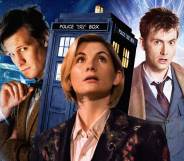How ‘beards’ have helped LGBTQ+ people stay safe for generations – and we don’t mean facial hair

Phyllis Gates and Rock Hudson (L), Johnathon Schaech and Ellen DeGeneres (R) – both Johnathon and Phyllis were ‘beards’ (Screen Archives/Ron Galella/Getty)
You may have heard the word “beard” used to describe someone’s partner in the past, but what does it mean?
Although the LGBTQ+ language and slang dictionary is always evolving and expanding, there are some words and terms that have a long-rooted history and “beard” is one of them.
From golden retriever lesbian to gender non-conforming lesbian and gold star lesbian, the diversity of queer relationships are defined in a wide-ranging manner and “beard” is another component of this.

What is a beard?
A beard is a person who – knowingly or unknowingly – dates or marries a gay person so that that individual can hide their sexuality. By appearing as though they are part of a heterosexual relationship, the idea was to negate any possibility of them being seen as queer.
In theory, one or both parties could be gay, but more usually the use of the word referred to a relationship between a lesbian and a gay man. In the case of a straight man dating or marrying a lesbian, the word merkin (in the US) and frock (in the UK) are sometimes used.

Where does the word beard come from?
The history of the slang word is synonymous with the terms lavender dating/marriage – or front dating.
According to The New Partridge Dictionary of Slang and Unconventional English, a beard is “a person who escorts another to a social function in order to mask the identity of one or the other’s lover or sexual orientation.” It seems as if this definition dates back only as far as 1956.
Beard can be used in heterosexual and queer contexts. However, the term has become engrained in LGBTQ+ communities. Prior to that context, the word was sometimes used to conceal infidelity in a supposedly monogamous relationship.
The word entered the vernacular more widely in the 1960s, a time when the usage became more understood as homosexual relationships became more visible, despite it being a time of rampant homophobia.
Before the sixties and WWII, these relationships were known as lavender marriages.
Beard has since been adopted by those in the queer community, and today, although we still use the term, with LGBTQ+ relationships being more accepted in some (but not all) countries, there is less need to hide your sexuality.
Who are famous examples of beards?
The word appears in Robert Campbell’s 1986 book The Junkyard Dog: “It’s supposed to look like the girls are for the clients’ entertainment, not his… Who believes that? Not many. He also has a respectable friend he uses as a beard.”
However, the most common use was in Hollywood when stars of the silver screen weren’t out as LGBTQ+ –because doing so would have destroyed their career.
It’s said that bearding became noticeable in the 1920s when actors’ contracts began to include morality clauses that prevented them from engaging in LGBTQ+ relationships and potentially damaging their celebrity image.
However, things got more complicated in the following decades. Between 1934 and 1968, the Motion Picture Production Code (known as the Hays Code) prohibited gay actors living freely. They could enter into a beard relationship privately but it was more likely that the studio would set these up.
Possibly the most famous case was that of Rock Hudson. The “beefcake” went as far as to marry to hide his homosexuality.
In 1955, a magazine threatened to publish an exposé about Hudson’s many male lovers. Not long after his agent had the story quashed, by sacrificing other clients to the media, Hudson married secretary Phyllis Gates.

However, in her 1987 autobiography, My Husband, Rock Hudson, Gates said she had married the Giant and Dynasty star out of love and insisted it was not to prevent a scandalous exposé.
Hudson was officially outed after his death from an Aids-related illness in 1985.
Elsewhere, The Golden Girls legend Betty White has heavily implied that she was a beard to the flamboyant entertainer Liberace. The pair were close friends and she regularly accompanied him to premieres to help counter rumours about his sexuality.

The star was desperate to hide his homosexuality and even when he died in 1987, his press agent gave the cause of death as a combination of pernicious anaemia, emphysema and heart disease, while his doctor put it down to heart failure caused by subacute encephalopathy, a degenerative brain disease.
He was HIV-positive at the time of his death.
In 2011, appearing on The Joy Behar Show, when the host asked if there was any doubt the singer and pianist – who won a famous lawsuit in 1959 against the Daily Mirror for insinuating he was a homosexual – was gay, White laughed and exclaimed: “Not at all.”
Other beards include author and garden designer Vita Sackville-West (9 March 1892 – 2 June 1962) and politician and biographer Harold Nicolson (21 November 1886 – 1 May 1968), who were married and had two children. It’s now understood both were queer.

In 2016, That Thing You Do! and Legends of Tomorrow star Johnathon Schaech replied to a Reddit Ask Me Anything question explaining his relationship with chat-show host and comedian Ellen DeGeneres.
“My manager asked me to accompany her to events,” Schaech replied. “She was scared people would not watch the show, her sitcom Ellen, because she was gay. It was an honour.”
It’s worth noting that not everyone is ready or comfortable to outwardly express their true selves so the process, even unconsciously, of bearding isn’t something that should be in any way criticised: if anything, it is a long-standing, historic tradition in the LGBTQ+ community – and nothing to be ashamed of.
How did this story make you feel?

